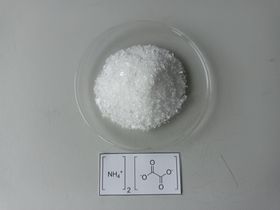Ammonium oxalate
 Crystals of ammonium oxalate
| |
| Names | |
|---|---|
| IUPAC name
Diammonium ethanedioate
| |
| Properties | |
| C2H8N2O4 | |
| Molar mass | 124.10 g/mol |
| Appearance | White crystalline solid |
| Odor | Odorless |
| Density | 1.5 g/cm3 (at 20 °C) |
| Melting point | 120–133 °C (248–271 °F; 393–406 K) (decomposition observed at 70 °C) |
| Boiling point | Decomposes |
| 2.36 g/100 ml (0 °C) 3.21 g/100 ml (10 °C) 4.45 g/100 ml (20 °C) 5.21 g/100 ml (25 °C) 6.08 g/100 ml (30 °C) 8.18 g/100 ml (40 °C) 10.8 g/100 ml (50 °C) 14.0 g/100 ml (60 °C) 22.4 g/100 ml (80 °C) 34.6 g/100 ml (100 °C)[1][2] | |
| Solubility | Slightly soluble in ethanol Insoluble in benzene, carbon tetrachloride |
| Vapor pressure | ~0 mmHg |
| Thermochemistry | |
| Std enthalpy of
formation (ΔfH |
-1,424 kJ/mol |
| Hazards | |
| Safety data sheet | Sigma-Aldrich |
| Flash point | Non-flammable |
| Lethal dose or concentration (LD, LC): | |
| LD50 (Median dose)
|
375 mg/kg (rat, oral) |
| Related compounds | |
| Related compounds
|
Oxalic acid |
| Except where otherwise noted, data are given for materials in their standard state (at 25 °C [77 °F], 100 kPa). | |
| Infobox references | |
Ammonium oxalate, also known as diammonium ethanedioate is a chemical compound, with the chemical formula (NH4)2C2O4. It can sometimes be encountered in nature, in guano.
Contents
Properties
Chemical
Ammonium oxalate will decompose when heated, to yield oxamide:
- (NH4)2C2O4 → (CONH2)2 + 2 H2O
Further heating will give off carbon monoxide, dioxide, water and cyanide.
Physical
Ammonium oxalate is a white crystalline solid, soluble in water. It is generally encountered as a monohydrate. Ammonium oxalate has a density of 1.5 g/cm3 at 20 °C.[4]
Availability
Ammonium oxalate is sold by many chemical suppliers. Can also be bought online.
Preparation
Ammonium oxalate can be obtained by reacting ammonium carbonate, bicarbonate or aqueous ammonia with oxalic acid.
Another route involves the hydrolysis of cyanogen, in a neutral or slightly acidic aqueous environment.
Heating a mixture of anhydrous oxalic acid and urea between 150 - 160°C will yield ammonium oxalate, as well as oxamide and carbon dioxide.[5]
Projects
- Make oxamide
Handling
Safety
Ammonium oxalate is harmful if ingested.
Storage
In closed bottles, away from acidic vapors.
Disposal
Ammonium oxalate can be destroyed by reacting it with a base, followed by pyrolysis.
References
- ↑ Hill; Distler; Journal of the American Chemical Society; vol. 57; (1935); p. 2203
- ↑ Rabinovich V.A., Khavin Z.Ya. Brief chemical reference book. - L.: Chemistry, 1977 (Рабинович В.А., Хавин З.Я. Краткий химический справочник. - Л.: Химия, 1977)
- ↑ Crenshaw, J. L.; Ritter, I.; Zeitschrift fuer Physikalische Chemie, Abteilung B: Chemie der Elementarprozesse, Aufbau der Materie; vol. 16; (1932); p. 147
- ↑ Alyaev; Belousov; Bukin; Efimova; Kuz'micheva; Rapoport; Roudenko; Chaban; Russian Journal of Inorganic Chemistry; vol. 47; nb. 3; (2002); p. 398 - 406
- ↑ Das-Gupta, J. M.; Journal of the Indian Chemical Society; vol. 10; (1933); p. 117 - 123